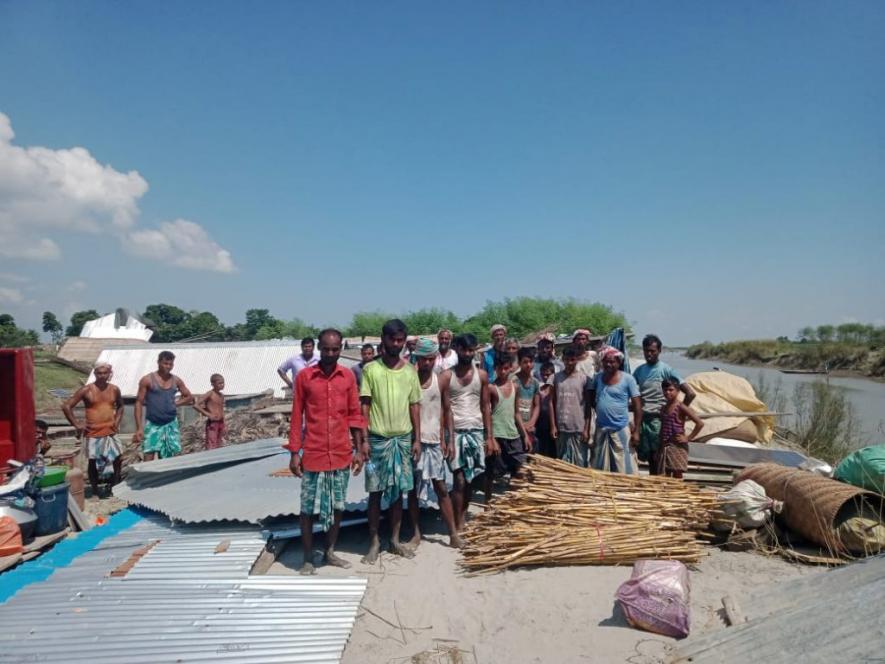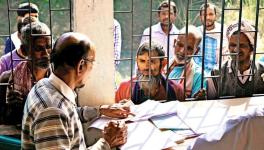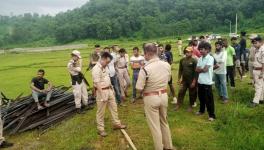Assam: Muslim Peasants Cultivating Land for Decades Evicted in Darrang Dist, 2 Killed in Firing

Image Courtesy: The Wire
As we publish this article, there are reports that the eviction of Muslim families in Gorukhuti in Darrang District by Assam Police took an ugly turn on Thursday with reports of police firing claiming at least two lives. Unconfirmed reports said the death toll could be higher. The area is tense as locals are resisting police action, said sources.
Breaking: Ten innocent peaceful protesters fired on by Assam police. Injured. Badly. Diabolical plans after midnight notices for eviction servd by admin of Darang District, a hit squad comes to Dhalpur villages under Sipajhar police station of Darang District to break homes.
— Teesta Setalvad (@TeestaSetalvad) September 23, 2021
Sipajhar, Assam: On September 20, Assam Chief Minister Himanta Biswa Sarma seemed “happy” over the eviction of 800 families from their homes in Dholpur No 1 and Dholpur No 3 villages of Darrang district, as according to his social media handles. What he termed the ‘clearing (of) about 4,500 bigha’ (land) courtesy an eviction was where families had been cultivating for decades, despite ravaging annual floods.
“It looked like a scene from a war; hundreds of police and CRPF personnel descended upon the villages equipped with 14 JCBs. The district administration mobilised 1,500 persons from the security forces to oust people who had already agreed to move from their homes to the land promised by district administration for temporary settlements,” said Mohammad Ali Khalifa, president of Assam Sankhyalaghu Sangram Parishad (ASSP), a minority rights organisation working in the state.
The eviction at Sipajhar’s Dholpur villages follow a similar pattern of forced displacements — ‘clearing land from encroachers’ — employed by the ruling Bharatiya Janata Party (BJP) government. On the evening of September 18, Anganwadi workers from the area distributed eviction notices to the residents of the villages. Ironically, the district authority had issued the same on September 10. However, the letters were given to the people after eight days, for reasons best known to the authorities.
The demolition of houses and displacement of about 5,000 people stem from the BJP government’s plan to start an ‘agricultural project’ in Gorukhuti. The area encompasses six villages and is inhabited by Bengali speaking Muslims. Following a cabinet meeting on June 5, the agriculture department constituted a committee for “development of land” for “agriculture and allied purposes” on 77,000 bighas of land in the area.
While the Assam government evicted these people from the Dholpur villages in the name of an agriculture farm, in other instances, the government has uprooted Muslim families, calling them
“encroachers”. On June 6, the Hojai district administration removed at least 70 houses of Muslims from the Kaki area. Prior to that, on May 17, 25 families, all belonging to the same community were evicted from Jamugurihat in north Assam's Sonitpur district. People of Dholpur No 1 village, a total of 49 Muslim families, were evicted from their homes on June 7, ostensibly clearing the “encroached” land of a Shiv temple. In the same month nearly 200 families were evicted from Patharkandi area in Karimganj district.
The series of evictions is in tandem with BJP’s poll promise of clearing forest and government land from encroachers and settling “indigenous” landless people on these lands. The ousting of Muslims from their homes and livelihoods is being seen as an act of “vindication” against the minority community.
“The government’s intention is to persecute, harass the Muslims and take political mileage from it. This is their planned agenda. Himant Biswa Sarma and (Prime Minister) Narendra Modi are acting like Hitler and are ruling like the second incarnation of the British,” said Ainuddin Ahmed, advisor of the All Assam Minority Students Union (AAMSU).
To protect themselves from the ensuing eviction, a few farmers had approached the Gauhati High Court at midnight between September 22 and 23 as the district administration had sent eviction notices to those families as well.
“These evictions conform to the anti-immigrant and anti-Muslim sentiment, which is the dominant political narrative in Assam. The media and other mechanisms which are instrumental in resistance are also controlled by the same ethno-nationalists who peddle and support such narratives. People who are vocal on social media are slapped with criminal cases. So, in such a scenario, it is a difficult situation for both the religious and linguistic minorities to organise themselves. But still they are writing letters and filing cases to defend their rights,” said Assam-based human rights lawyer Tania Laskar while describing the lack of resistance against the evictions.
‘Community Farm’ After Evicting Community
In its cabinet memorandum, the Assam government had said that despite having potential, the land had underutilised. The BJP government had allocated Rs 9.6 crore for agriculture and allied activities for utilisation and development of the land in the area, a claim which locals dismissed as political “exhibition to appease the anti-Muslim majoritarian nationalists.”
The site of the government’s project is known as surface land; the land finds itself in the middle of river streams and is flanked by the Brahmaputra and its tributary Nanoi river on either side.
Saddam Hussain, a social activist from Kira Kara village, whose family is also facing evictions, said: “The government wants to implement the project in the middle of the river on land which remains submerged for seven to eight months in a year. Neither ponds to rear local fish, nor cow sheds will survive the gushing flood waters and silt deposits. The project itself is not feasible in the first place, so spending such a huge amount of public money is a complete waste and irrational.”
Farmers from Dholpur village, who have not been evicted yet, but have received eviction notices, also categorically refuted the claim of ‘underutilisation’ of the land, saying that they were cultivating at least two crops during times when it wasn’t flooded. Braving the “constant risk of floods ravaging crops”, farmers from this area sometimes grow three crops as well.
“We adjust the sowing time, predicting the rains and utilising time best so that we can harvest our produce; we keep our boats ready to take our livestock to safety during floods. We grow corn, jute, peanut and perishables such as cabbage, brinjal and cauliflower to sustain our livelihoods and feed our people”, said 55-year-old Alauddin from Dholpur No 1. He has received an eviction notice.
Dholpur, and other five villages, which the government intends to clear for the proposed farm, is situated around 60 kms from Guwahati, the seat of the ruling elites of Assam. It takes a road trip and a boat journey to experience the scenic place. The rivers, gentle breeze and green fields during the boat journey present a mesmerising sense of beauty during the non-flooding season. While the Bengali speaking Muslims dwell in the middle of the rivers, the Assamese Hindu and Assamese speaking Muslims reside near the Gorukhuti embankment — it protects them from annual floods — far from the flood plains.
Taking on the government’s excuse for the agriculture project, Alaudddin further said: “We are peasants and we utilise the land properly whenever it is not flooded. In fact, we take land on rent from Hindu people who do not cultivate their land due to the fear of floods.”
Fifty-two-year-old Hazrat Ali from Dholpur alleged that the government was harassing Muslim farmers by trying to set up the agricultural farm. “As we live in the middle of the river, if we are evicted without any reason then when the floods come we will again have the option to come back here again. But by setting up the agriculture farm they are actually trying to annihilate any chance of our return,” he said.
Over the last week, the entire area was flooded as rain lashed Assam. Prior to the flooding, the government had already tried to initiate agricultural activities by tilling the land and acting on other things. However, floods damaged all the progress made by the government on the agriculture farm. It was a development which Hussain termed “a way to waste Rs 9.6 crore by repeating the same mistake.”
“Not Eviction, Illegal Land Grabbing By Govt”
The Assam government has said that the ‘freed land’ and agriculture farm would provide employment to ‘indigenous youths’ of Assam. The move is being seen as a partisan tactic used by the Sarma-led BJP government.
Terming this majority appeasement politics, Hussain said: “They want to settle 500 unemployed people by evicting 1,000 peasants, which means that the government wants to provide employment to 500 unemployed persons by stripping around 7,000 to 8,000 people of their livelihoods and shelter.”
Abdul Kalam Azad, a PhD candidate at Vrije University Amsterdam, who has extensively researched evictions during the previous BJP government led by Sonowal, said, “This is not eviction; it’s illegal land grabbing by the government. Most importantly, the land grabbed from the Muslim peasants will now be given to the collective of so called indigenous youths (read Hindu youths) for cultivation,” he added.
“To understand what message it conveys, we need to understand how Assamese society is reacting to these series of evictions. There is pin-drop silence in the media and in the civil society space. Assamese civil society has given its approval to a crime of this magnitude. Muslims have been sidelined from the mainstream imagination of Assamese society.”
He alleged that under the first six months of the Sonowal government at least 3,500 families were uprooted and that evictions have continued unabated since then.
Commenting on the way Sarma has been painting the evictions, he said that the CM was trying to prove that he was more brutal than his predecessor. “He not only issued instructions to demolish homes of poor victims but also celebrated the mayhem. This is inhuman and unprecedented,” he continued.
Government Reneges From Promise
As far as the state government and district administration was concerned, the authorities neither kept their promises nor paid any heed to pleas for temporary rehabilitation so that victims would be able to take away their belongings.
“The CM had said that there were 3,000 families residing in the villages and if each family was given four bighas of land then 12,000 bighas of land would be allotted to the residents and the government would set up the agriculture farm in the remaining area. But the CM did not keep his promise,” said ASSP’s Khalifa.
On September 19, 2021, when a sea of security forces arrived near the village, people agreed to negotiate with the district administration for a settlement. The local community leaders, including representatives from AAMSU and ASSP, agreed that the farmers would be given some time to shift to other places.
Though the people were taking down their tin shanties on September 20, however, “despite the district administration’s assurance, people were given no time and JCBs bulldozed houses of people starting from 6 am. They did even not spare the mosques. We sought three days to remove the mosque structure,” Khalifa said.
Residents alleged that the administration did not pay heed to their belongings either, seemingly hell-bent on demolishing the tin walls and other items belonging to evicted families which they had kept aside to take with them later. After complaints by the locals and community leaders, the district administration stopped the bulldozers from plying on their belongings.
Who Are the ‘Encroachers’
The people who first settled in the area are in their late 70s and 80s. Once a parched sand dune, the neglected land hosted climate refugees and victims of the violent Assam movement from various districts.
One of the earliest settlers in the area is Jainal Abedin, who lives in Fuhuratoli village. The septuagenarian migrated from Dhubri district in the 70s, to Darrang district’s Bontapur village. However, flood induced erosion compelled him to migrate again and he took shelter at Fuhuratoli.
In fact, it was Abedin who fought for land allocation for the climate victims and the Gauhati High Court later allotted 995 bighas of land to 199 families.
Similarly, 84-year-old Khabar Ali has been living at Fuhuratoli village since 1993 after his house was washed away at Nanglichar, a village around 30 kms away from his current home. “I lost my home so many times. In 1983, my home was burnt by mobs during the riots, and later, the Brahmaputra swept away whatever I had. Now I may have to lose my home again,”, Khabar told this reporter earlier.
Ali was born in Muamari village under the Mangaldai constituency prior to Independence. After 1947, the Assam government removed people from the village and allotted them land in Chenibari under the Kolaigaon constituency. However, the 400 families chose to move to Nanglichar as it was convenient for them to farm there. Following the 1983 carnage and successive erosions, most of these families moved to Dholpur, Fuhuratoli, Kekurua and nearby areas.
“We are among the oldest people to live here. We have seen people settling here after their homes were demolished either by floods or by the mobs during the 1983 Assam movement. It is hard to believe that all our lives we have been forcefully displaced,” said 76-year-old Momin Ali.
Over the years, the government itself set up educational institutes, a few public health centres apart from other welfare schemes for the empowerment of char dwellers. Similarly, the char land, which the Himanta-led government wants to free from ‘encroachers’ for ‘agricultural purposes’, has three primary public health centres, two upper primary schools, 40 primary schools and 42 Anganwadi centres.
Momin once told this reporter: “Earlier it was the hateful mob after us, and now the government has chosen to come after us.” He was talking of 1993, when angry Assamese nationalists chased his fellow villagers.
Though the district administration has said that the evicted families will be given a temporary settlement on 1,000 bighas of land nearby, activists said the land was not suitable for habitation as it is too low-land.
The families, who live under the threat of eviction, see it as a challenge for them as well as for the younger generation. “Young adults and children who are attending school will have to leave and migrate to other places. Their chance for an education will be lost and they will remain in a cycle of poverty. As for the farmers, they will become labourers in the fields they once cultivated,” added Hussain.
Since the BJP’s ascent to power in Assam in 2016, it is for the first time that the government has been on an eviction spree, terming the settlers as “encroachers''. This is the fourth time that the government has uprooted people from their lands in Dholpur village — the first eviction happened in November 2016, the second in January 2021 and the third time in June 2021.
The writer is a freelance journalist based in Assam.
Get the latest reports & analysis with people's perspective on Protests, movements & deep analytical videos, discussions of the current affairs in your Telegram app. Subscribe to NewsClick's Telegram channel & get Real-Time updates on stories, as they get published on our website.
























